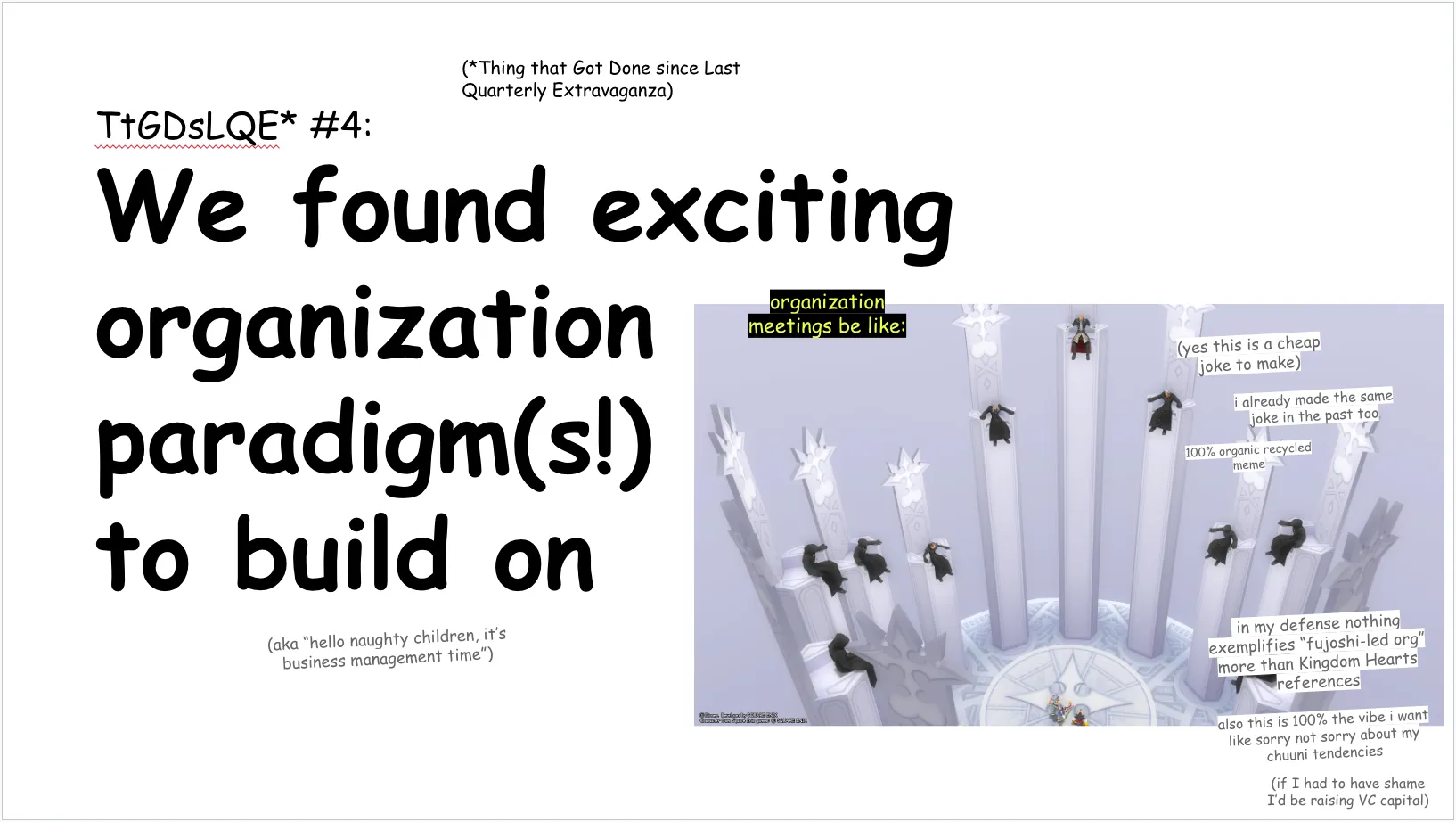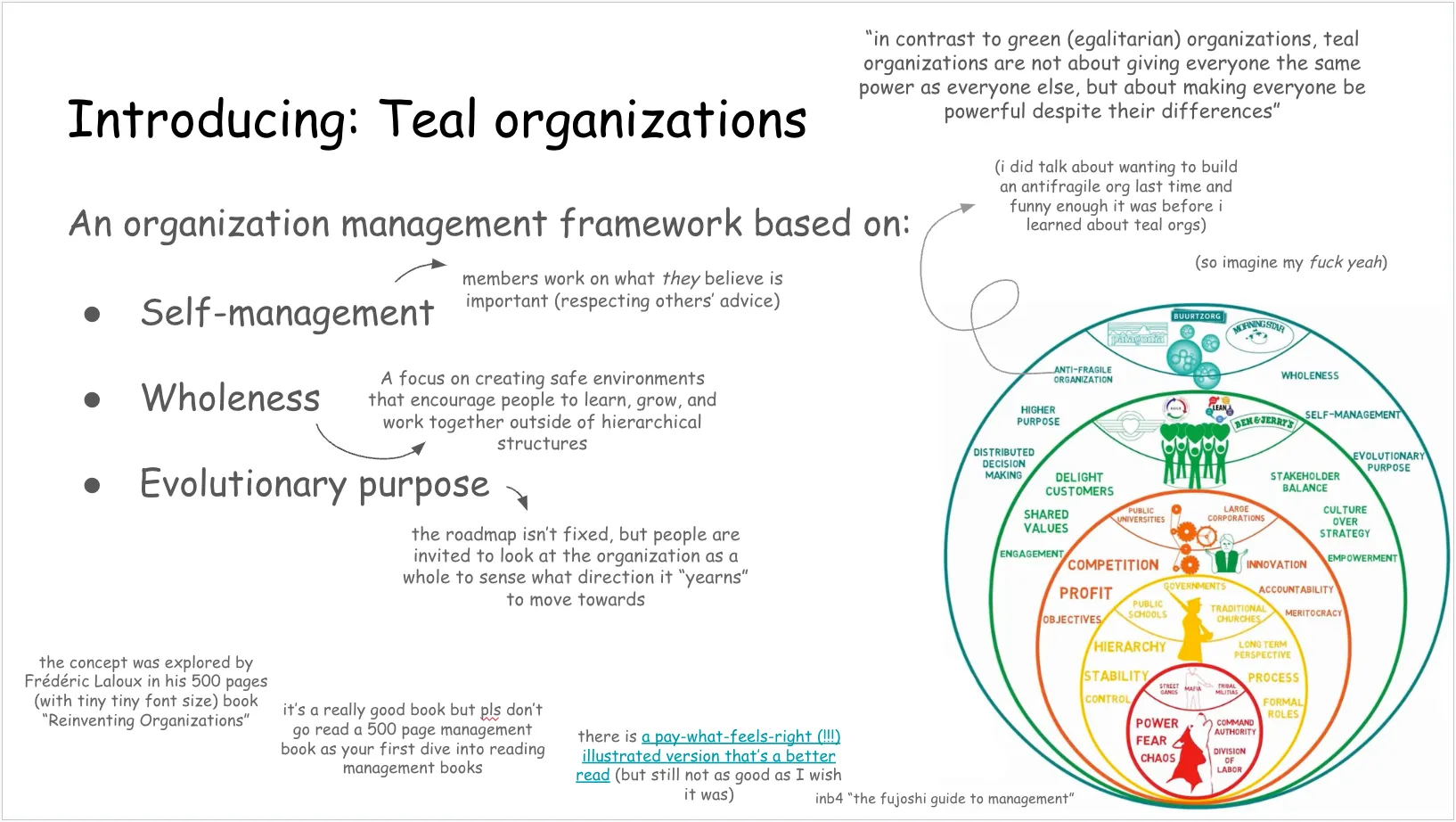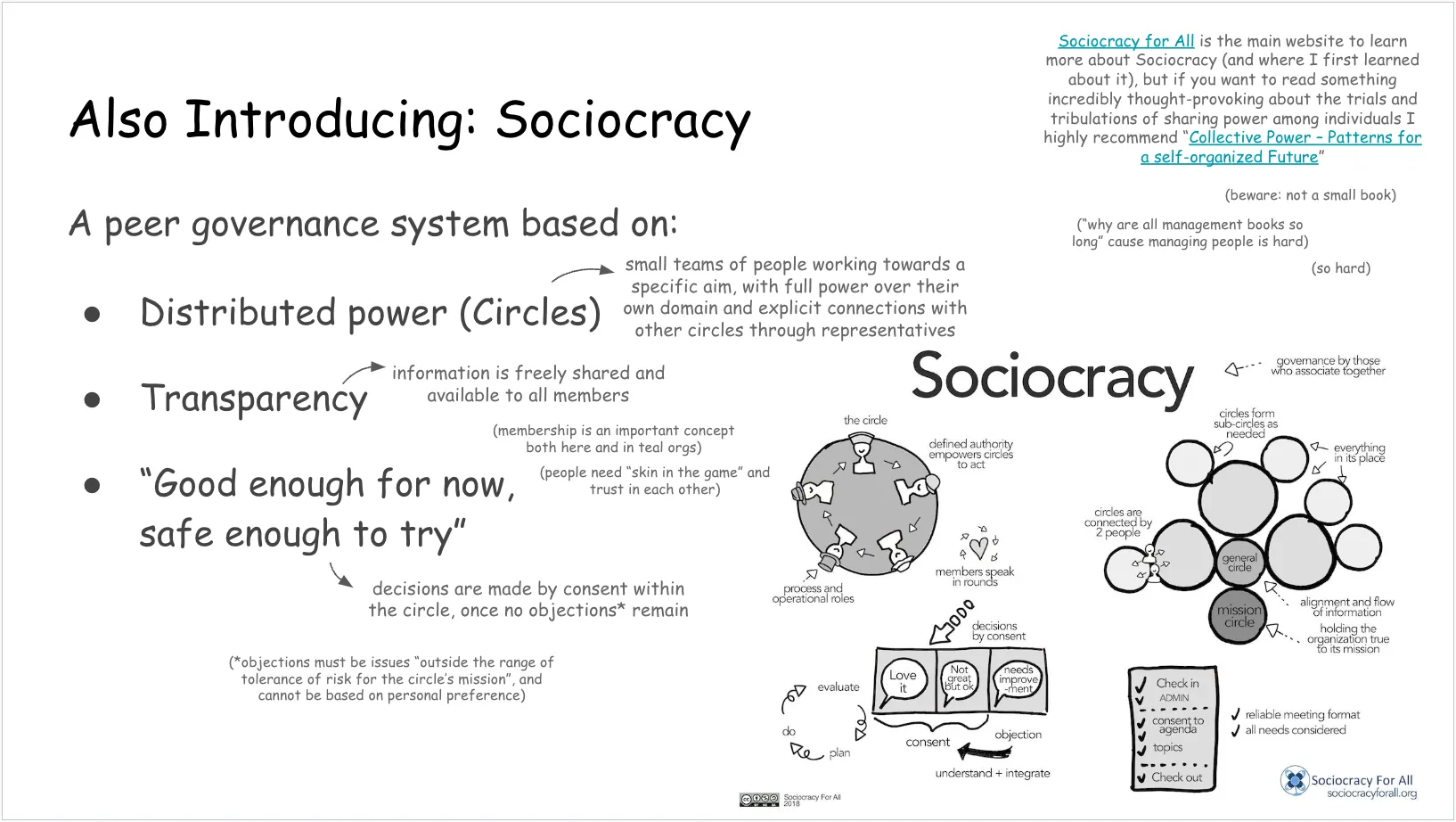The Quest for an Ethical Organization
What do you mean "no one has quite figured it out, yet"?
Table of Contents
Anon on Tumlbr asked:
Hello, your proposition about ethical business really intrigued me, and thank you for pointing my way to the Sustainable Economies Law Center! I really wanna learn more about this, but I don’t really know where to go, do you mind sharing if you have any more sources of reference?
Thank you for asking, anon! As it turns out, you just activated one of my trap
cards special interests. So, time for a story, an infodump, and the public
unveiling of my Extravaganza #4 slides.

Searching for Wisdom
When I started working on better online spaces, I knew that to tackle a problem of that size I’d (eventually) need to form an organization to oversee the effort. Despite being a much more innocent, bright-eyed software engineer whose experience predominantly came from within large corporations, I had heard plenty of horror stories about independent efforts degenerating into a mismanaged mess, and was determined to figure out how to avoid this happening. After all, my goal was to build an organization that would carry forward my ethical principles in a way I could be–ideally, remain–proud of.
My plan was overall straightforward: go very, very slow, find more experienced people to hound with questions, then, after finding the organizations who are Doing It Right™, copy their homeworks. After a lot of false starts, however, I came to a realization: in the overwhelming majority of cases, organizations haven’t really figured out how to solve the problems that come when many people are working together towards a goal1–no matter how much everyone in it cares about the goal and wants the effort and organization to succeed.
The Truth about Organizations
Nowadays, I believe that organization don’t start “good” and become dysfunctional through the incompetence of misguided individuals; instead, without someone desperately working to remain ahead and pull them out of inevitable issues, they naturally devolve into chaos. Managing an organization is a countinuous struggle against the tendency groups of humans have to go against the best interest of the collective.
Now, I imagine this could come across as a misanthropic position. I don’t believe that’s the case. In a perfect world, humans would have their needs met, their lives stable, and would be taught effective collaboration and collective governance as they grow up. Instead, we’re all operating in a world that’s crumbling around us, while carrying around intergenerational work trauma born out of a world where people build empires on the shoulders of those below them.
In this situation, even if you want to build the best, most stable organization, how are you supposed to know how to do it? And even if you set out to be better at it than most–more careful, more understanding, more informed–how are you supposed to continue doing it while the amount of people bringing their own baggage in grows, and you find yourself shorter and shorter in time and emotional energy?
Looking Beyond the Web
At my most frustrated, I would have almost told you this is an impossible problem that no one quite knows how to solve. However, by almost accident2, I found out about two different (but similar!) ways to run businesses and organizations that are currently being researched and popularized:
- Teal Organizations, an organizational theory centered on worker autonomy and peer relationships.
- Sociocracy, a theory of governance centered on consent and psychological safety.
Now, there’s way too much I’d want to infodump on when talking about these paradigms. However, I’ll have to leave that for another article. Instead, I’ll try to give you pointers about where to learn more3, and attempt to not be carried away.
Teal organizations
Teal organizations have been studied by Frederic Laloux, a former McKinsey partner4, for his book Reinventing Organizations. Compared to the books on Sociocracy (in the next section), “Reinventing Organizations” is targeted towards a business management public, and it’s a 500-page read I struggle to reccommend to people who aren’t used to them. All of that said, both this book and its illustrated version (a lighter read, but still not great), are available as “pay what you want”. So, if you’re curious, do consider downloading them and giving a read to the sections that look interesting, or to the end of chapter summaries. Skip Part 1 and go directly to part 2.

Sociocracy
While Sociocracy has a deeper history than Teal organizations, I’ve found out about it (and got most of my information) from Sociocracy for All5, a nonprofit dedicated to promoting sociocracy as a sustainable way of governance. They have a lot of different books available, but here’s two I recommend:
- Many Voices One Song, a “comprehensive manual covering all topics relevant to sociocracy in organizations.” This is bigger than some of the very small books they have, but not huge. While it acts as a manual, it also explains the theory behind the governance models it proposes, and it will definitely provoke thoughts and provide valuable insights even if read “recreationally”.
- Collective Power, a book on “effective collective building principles, that highlights unity, power sharing, and governance as crucial for impactful change”. This is a lot more theoretical than the previous book (and much longer), but it’s an incredibly enlightening exploration of the problems that arise when trying to work collectively, and what can be done to lessen them.
You can find the table of content for both books at the link. There are some free sociocracy resources on their website too, but I haven’t personally made use of them6.

Knowing the Path vs Walking the Path
While I’m obviously very happy about having found these systems, I’m always somewhat nervous about sharing them without caveats. Indeed, while having found guidance makes the journey easier, it doesn’t (unfortunately) make it easy. As we move to understand how we can implement these system in the organization(s) me and my allies are building, the complexity of fitting these systems within our limitations remains daunting. You cannot simply read a book and implement it, and there are unique (and less unique) challenges we face that make this an uphill climb.
Unfortunately, I believe, people are often less charitable with people who try to do things right and fail, than with people who just
Issue 0 – Money
Let’s get it out of the way: the answer to a lot of “how do we…?” can be straightforwardly solved by throwing money at the problem. Whether it’s hiring someone who can get things done efficiently and independently, paying for the help of an expert, or buying classes (or books) for collaborators7, money is a convenient way to make a hard journey easier.
Most importantly, however, money buys time. Time to figure things out, time to try and fail, and time to eventually learn how to succeed.
Without money–tale as old as time–progress is harder, slower, and more brittle.
Issue 1 – “Unfortunately, as you probably already know, people”
More originally (and yet somewhat still obviously), “the tendency of people to be, well, people” is a huge barrier in creating an organization that works. As I’ve touched upon in the beginning, society does not equip us for the inevitable difficulties of working collectively towards a shared goal.
Even further, the reality of a life under capitalism is incredibly stressful for everyone involved.Especially with a group that is so heavily full of neurodivergent, disabled people whose life can becoem chaotic at any minute, and have often been full of trauma and rejection, it’s easy to accidentally step on each other’s toes. And even when no toes have been stepped on, we’re still fallible. We have bad days, we say the wrong thing, we misunderstand. And rifts take time and energy to heal.
It’s impossible to arbitrate all conflicts that happen in a group, unless you can specifically hire someone trained to do so (which you most likely don’t have money to do). People willing to arbitrate are rarer and rarer these days (they burn out quickly, and many of us know better by this point). And unfortunately, people most often don’t know how to confront each other, and allow resentment to brew, or see any confrontation as zero sum conflict.
Issue 2 – Trust and Psychological Safety
Something that’s repeatedly called out by books on both types of organization is how trust and psychological safety are paramount when it comes to building an organization that works. This in part relates to what I said before: when people come in with their own baggage and trauma, it’s easy to accidentally trigger conflict. But beyond that, trust and psychological safety require building structures and practices that don’t come for free, and that require both emotional work and the ability to sit with and analyze their own discomfort from everyone involved.
But most of all, trust and psychological safety requires a degree of being exclusionary with people that don’t mesh well with the group’s culture and working style. And the only way we have around this exclusivity impacting the overall inclusivity of the broader efforts is to have more groups doing work, and more people leading those groups so the burden of fighting for everyone isn’t placed on the effort of a few.
Issue 3 – Skin in the Game
People have different availability of contributions, different degrees of energy, and different (and diversely rare8) skills that they can bring into any effort. While it’s true that all this intersects with issues of diversity, and that a fair and just group must be careful to not uncritically bring capitalistic ideals back into their work, it’s also true that not everyone doing work is doing an equal amount of work (or an equally irreplaceable one9), and is not as committed and dedicated to the mission at hand.
Eventually, people have different levels of “skin in the game” when it comes to moving an organization forward. For many reasons, some of us are used to treating organizations (and the software and projects they build) as a spectator sport, and believe that as the “customer” or target audience, organizations are beholden to catering to our own desires. Conversely, others believe that their desires never matter, and that they have no ability to took issues they care about into their own hands and champion them to resolution.
People don’t know what accountability means, and seek responsibility for decisions, without responsibility for results.

The Future and How to help
Having vented my frustration and fear about the future, I want to stress how grateful I am to have found much better guidance on how to organize something as ambitious as the organization(s) I’m trying to build [TODO: link to post]. Obviously, it’s not going to be just snapping fingers and making it happen. It’s going to be frustrating at times, messy even. But when people deeply understand and respect this, it becomes easier to work togeether to make these the best organizations they can be.
It will take a bit before we can open up and welcome more people into our group. A lot of coordination and work is going on behind the scenes. Once we do, when people are willing to come in and pitch some help, it’s important that they understand that this is not just fitting into a well-oiled machine, it’s building the machine itself, and be an active participant in the never-ending task of keeping it from breaking.
In the meantime, if you want to help, here’s how you can always help:
- Boost this article on socials. If you can, react to it! Add tags or comments, and join in the conversation. Help us bringing this discussion to the larger web.
- Become an official $upporter on Patreon or on this same website.
- Follow us to be alerted of opportunities to collaborate on our open source projects, or offer feedback on some of our material.
Very excited for the future!
Footnotes
-
The pattern generally went like this: Ms Boba, eyes shining bright, finds a new organization with an interesting management system . Some time later, some news comes out about the organization’s internal struggles, and she realize those who she thought “got it” don’t actually “got it”. Rinse, repeat. ↩
-
A friend of a consultant I hired recommended me a book on building organizations, and I miracolously remembered to actually buy it 3 months after being told about it. Take that, ADHD. ↩
-
If you want to skip the reading and just be reccommended one book, my vote for a committed but casual reader goes to Collective Power. ↩
-
If you’ve never heard about McKinsey, John Oliver dedicated an episode to them. I mention them here because, while I 100% believe amazing people can work for unethical companies (and even end up radicalized by the experience), Laloux’s line of work explains the context he’s coming from in his research. Don’t let this stop you from reading the book and learning more about Teal Orgs though. It’s great stuff. ↩
-
Funnily enough, I found out about Sociocracy for All from a newsletter that I found out about from resources on Teal Organizations. If this all sounds connected, it’s because it is. While these are different systems, once you learn about them both, similarities start emerging. ↩
-
Clearly you don’t need free resources when you have a book-buying problem. ↩
-
Both the sociocracy and the teal organizations books call out “training” as one of the “must have” requirements for the successful onboarding of employees. Among the training they both emphasize is effective conflict resolution, which is something I’ve seen people repeatedly struggle with in our communities, and that I wish I had money to train everyone in. ↩
-
Maybe an unpopular thing to say, but something I struggled with a lot before I talked with other people doing this type of work and realized it was not a “me” problem: people who can take a nebulous task, and bring it to completion without constant handholding at an acceptable level of quality are incredibly rare. While it’s true that not enough people get given opportunity to shine, and that capitalism undervalues certain talent, it’s also true that “talent” is in short quantity.
An important caveat: this doesn’t mean that people cannot be taught or trained into becoming better at this type of work. A lot of collaborators I’ve had the pleasure to work with have gone from not knowing where to start to incredible project leads. But this takes time, energy, and training, and it’s notoriously something that (if you heed the advice given to startups) you shouldn’t do until you have, well, enough money to do so. You can see then how this impacts marginalized folks who’re less likely to be given chances, and why this is by itself a byproduct of discrimination, even though we still need to contend with it. ↩
-
While it’s true that certain people and skills are hard to replace, one must make sure that this doesn’t become an excuse to compromise on other principles. However, the ability to do this also hinges on being able to train more people in doing certain work, creating processes around it, and being able to hire expertise should someone who was in a crucial position need to step down for any reason. Once again, things that are more easily solvable with money. ↩